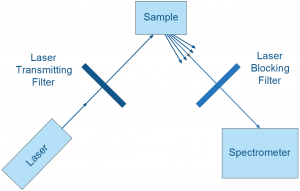Raman spectroscopy, enhanced with advanced filters, provides real-time data on biological tissues, holding immense potential in medicine, research, and biomedical engineering. By utilizing precise configurations and carefully chosen filters, Raman spectroscopy can deliver detailed information crucial for various biomedical and bio-analytical applications. The right laser wavelength and optimal filter choice are essential and vary depending on the biological sample being analyzed.
Raman spectroscopy involves illuminating a sample with a laser beam and analyzing the resulting scattered radiation. This scattered light is divided into Rayleigh scattering (at the laser wavelength) and inelastic scattered light, known as the Raman signal. The Raman signal provides valuable information about the sample, while Rayleigh scattering, with its higher intensity, is filtered out using laser blocking filters (notch, edge pass, or band pass filters).
Historically, holographic gratings and multiple dispersion stages separated Raman scattering, which was then collected by photomultipliers. Today, advanced optics like notch or edge filters eliminate unwanted Rayleigh scatter, providing a clear Raman signal.

Shanghai Optics specializes in custom Raman edge filters, bandpass filters, and notch filters designed to block the laser line and transmit anti-Stokes Raman scattering. We also offer laser line filters that transmit the precise wavelength of laser light required for sample illumination while blocking other radiation, enhancing the signal-to-noise ratio.
Our engineers and designers are available for consultation to help determine the ideal wavelength ranges, optical density, and filter type for your specific application. We also assist in configuring the optimal angle of incidence for your system.
Contact Shanghai Optics today! We’d be more than happy to discuss your projects and how to best bring them to fruition.